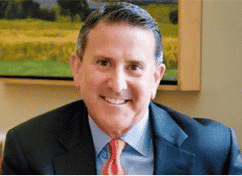Leader

Gutsy decision to oust current CEO Mark Fields, a 25-year Ford veteran, in favor of Jim Hackett, a Ford outsider and most recently the CEO of Steelcase. Hackett had most recently been running Ford’s Smart Mobility initiative.
In all fairness, Fields had a tough act to follow; he followed Allen Mulally’s rock star tenure as Ford’s CEO. Mulally, another industry outsider, was personally responsible for averting Ford’s bankruptcy and refusing a government bailout — the only legacy automaker to do so. A CEO of our times, to be sure.
The bigger difference between them however may actually have been Mulally’s leadership ability, where he demonstrated transparency, a culture of positive leadership and the real benefits from working together, no easy culture shift for a behemoth like Ford. None of those traits personified Fields, more known for his combative approach than any easy-going personality. Fields is the guy who said that employees worrying about their pensions would be “a great motivator.” Cultures are hard to manage, and clearly Fields failed at driving Ford’s.

Late to the game
Fields, as CEO, said repeatedly that Ford didn’t want to be the first company to offer self-driving cars. Conversely Bill Ford felt otherwise, saying “I don’t want to be slow. We need to be quick in everything we do.”
Fields was playing catch-up, using the backs of employees to fund the effort; he announced earlier this year a plan to cut 3 billion in costs and as many as 1400 white-collar jobs. I can imagine the discussion… “Let’s get innovative!” says Fields. “Great—how do we pay for it?” says senior staff. “Let’s whack a couple thousand surplus employees—that’s a good start,” says Fields. A decidedly un-innovative approach; CEOs have been whacking folks to save a few bucks since time immemorial. It ain’t new.
The auto industry is being disrupted by companies like Tesla, Uber, and even Google and Apple with their self-driving efforts. Add to that the completely predictable decline in US auto sales, and you start painting a pretty good example of a lack of vision.

Thankfully, indeed. Hackett knows what it’s like to lead 100-year-old company; he views change is critical to the company’s survival; and he has a history of giving fans what they want. Exactly what is needed at Ford today.
Bottom line, if automakers are going to stay around, they need to get off their collective butts, invest in new technology, and make some things happen. Investments today will allow survival in the future. But you must have the courage to see the future, set a vision, then pursue that vision violently.
I may wish you would have fired Mark Fields a year earlier, Bill Ford, but you’ve taken a step in the right direction. Tough job, but it does make you our Leadership Leader for May.
Milquetoast
John Skipper, President ESPN
It seems everyone on our leader-laggard list this month is whacking people left and right. ESPN recently laid off (that’s fired) about 100 people (10% of the total workforce), most of them on-screen personalities from various shows and reporting efforts. Executives claim it’s a simple branding reposition and not a mandate from parent company Disney.

“Dynamic change demands an increased focus on versatility and value, and as a result, we have been engaged in the challenging process of determining the talent—anchors, analysts, reporters, writers and those who handle play-by-play—necessary to meet those demands,” Skipper wrote to employees.
What a load of crap. The reasons are always simple for layoffs. Someone made some mistakes along the way, and the answer to those mistakes is short-term money-saving via reduce payroll. ESPN claims to have outlined a new strategy for the network, including an increased focus on its ESPN app with the multiscreen approach around big events, more live news video, and enhanced video and audio streaming. They also plan to bolster ESPN’s online presence
Look, ESPN has been hemorrhaging subscribers for several years now (roughly 12 million in six years), a natural result of fewer people attached to cable televisions as a revenue source. Considering ESPN pays billions of dollars to various leagues to be able to broadcast these events, they simply didn’t prepare for the sudden decline in revenue. It seems the only people that didn’t realize fewer people are using cable, ergo fewer people are paying for televised events, was ESPN. I knew it, you knew it, my neighbors knew it.

Now, let me throw a wrinkle into this: ESPN is not our Leadership Milquetoast this month because they laid off hundred people. No, they are our milquetoast because they still haven’t fixed their business model, and this layoff is a distraction that further postpones any real and meaningful shift in strategy. Just do something is a juvenile response to a valid business need, and confuses activity with meaningful change.
It’s that ridiculous activity — instead of impactful business change — that brings ESPN and John Skipper into our spotlight, pulling down our dubious Leadership Milquetoast position for May.
Laggard

What the hell are you doing, Brian?? TGT stock has been on a vicious two-year decline, currently trading at a five year low, a market-cap reduction of almost $13 billion. Waiting until just after the nick of time to exit the Canadian market, that was a $5B+ write-down. Same store sales and total revenue have fallen for four consecutive quarters.
All of this after Cornell announced a two-year turnaround plan in 2015, committing to cut costs, prioritize merchandise categories, increase grocery and online sales and open more small-format stores.
Oops… seems he now needs a turnaround plan for the turnaround plan.
At a time when innovation and strategy need to be at the forefront, Cornell whacked Casey Carl, Target’s Chief Strategy and Innovation Officer. It seems Carl, a 20-year Target veteran, was a bit too innovative and strategic. Now, the strategy is to copy Wal-Mart — remodeling existing stores, investing billions in lower prices, and hoping really hard that online sales increase (that last one wasn’t Wal-Mart’s, just Target’s).

And while we’re discussing whacking folks… don’t forget the departure of the Chief Marketing Officer, Chief Legal Officer, Chief Human Resources Officer, Chief Stores Officer and the head of the grocery division; since Cornell’s ascension, only 2 of the 11 executive leadership team remain. Lots of things can cause such a leadership turnover, but most of them are bad, and all point to the CEO.
This will obviously be a test of patience for Target’s Board of Directors. Unlike Ford, this month’s Leadership Leader, the Target board has demonstrated a penchant for moving way too slowly on CEO decisions. Their undeserved patience helps vault Brian Cornell into our Leadership Laggard for May.

